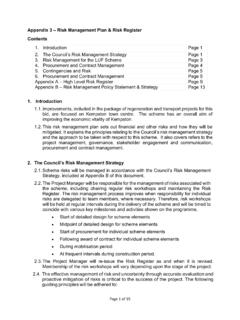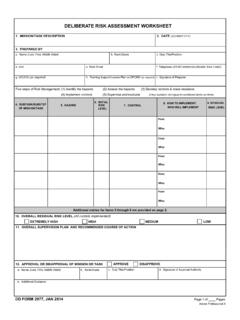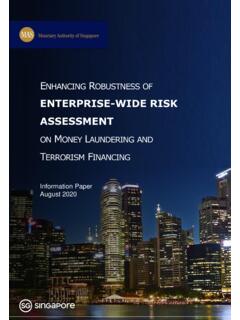Transcription of CAPF 160 DELIBERATE RISK ASSESSMENT WORKSHEET
1 Reset CAPF 160 - DELIBERATE RISK ASSESSMENT WORKSHEET . 1. ACTIVITY 2. DATE (DD/MM/YYYY). Meetings / Activities / Operational Missions 17/03/2020. 3. PREPARED BY. a. Name (Last, First, Middle Initial) b. Rank c. Duty Title/Position RAY, WILLIAM, G. COL ORWG CC. d. Unit e. Email f. Telephone PC-OR-001 (503) 453-5833. g. Signature of Preparer // signed // William G Ray Five steps of Risk Management: (1) Identify the hazards (2) Assess the risks (3) Develop Controls & Make Decisions (4) Implement controls (5) Supervise and evaluate (Step numbers do not equate to numbered items on form). 4. SUB- ACTIVITY or 5. HAZARD 6. INITIAL 7. RISK CONTROL 8. HOW TO IMPLEMENT/ 9. residual . SPECIFIC TASK RISK LEVEL WHO WILL IMPLEMENT RISK LEVEL. Note: Each sub-activity Consider Hazards from each of the Use Risk Describe the actual control being Describe Describe how the risk control will be Use Risk or task will probably 5-M categories in CAPP 163: ASSESSMENT used to address the specific risk.
2 Implemented and monitored, and ASSESSMENT have multiple Matrix on who is responsible. Matrix on - Member hazards/ risks associated page 3. page 3 of - Medium with it. Each one should - Machine form be assessed. - Mission/. Activity - Management Advised not to attend if having any How: If member is ill stay home and Member COVID -19 symptoms consistent with an seek treatment/ Isolate /. Transmission /come ill EH infectious disease. Direct phone is preferred/ Use Observers / asking on quarantine H. to gathering check-in Who: CC / Project / Activity Officer How: Notification to members and Unit Meeting / COVID -19 Statewide school attendees that operations Activities Transmission EH closings / Meetings are suspended due to virus M. and Activities canceled Who: Wing CC / Group CC / unit CC. How: Planned activities will be Wing Activities COVID -19 Statewide school rescheduled or canceled as needed Transmission EH closings / Meetings M.
3 And Activities canceled Who: Wing CC / SE. ADDITIONAL SPACES FOR ITEMS 4 THROUGH 9 PROVIDED ON PAGE 2. 10. OVERALL residual RISK LEVEL - (The highest residual risk level in Column 9, with all controls implemented): EXTREMELY HIGH HIGH MEDIUM LOW. NOTE: ALL residual risks ASSESSED AS "H" OR "EH" MUST BE APPROVED BY CAP/CC. 11. OVERALL SUPERVISION PLAN AND RECOMMENDED COURSE OF ACTION: Wing SE and HSO will collaborate and continue to monitor CDC, OEM and NHQ guidelines, and provide any additional recommendations to Wing command staff. All Meetings and Activities canceled until 11 May as per NHQ, with the exception of active operational missions, until the virus has been contained or restrictions lifted. 12. APPROVAL OR DISAPPROVAL OF MISSION OR ACTIVITY APPROVE DISAPPROVE. a. Name (Last, First, Middle Initial) b. Rank c. c. Duty DutyTitle/Position Title/Position d.
4 Signature of Approval Authority CAPF 160, Sep 19 1 of 4. CAPF 160 - DELIBERATE RISK ASSESSMENT WORKSHEET . (Use CAPF 160HL if additional space is needed). 4. SUB- ACTIVITY or 5. HAZARD 6. INITIAL 7. RISK CONTROL 8. HOW TO IMPLEMENT/ 9. residual . SPECIFIC TASK RISK WHO WILL IMPLEMENT RISK LEVEL. LEVEL. COVID -19 Cleaning and Sanitizing units How: All tables, chairs , equipment, All meetings and meeting locations when computers, and door knobs will be wiped down with approved germicidal products and activities Transmission / EH meetings resume. Never mix prior to the start of a meeting M. Contaminated surfaces ammonia and bleach Who: Unit CC / Activity directors How: As per NHQ no gathering of All Activities COVID -19 Social Distancing / more then 20 people ratio 1:20. Transmission during EH meetings and Meetings and activities canceled M.
5 Gatherings activities canceled Who: Wing CC / SE. How: Members exhibiting symptoms, or who have All Activities COVID -19 Self Quarantine / traveled to or through infected areas will self quarantine from CAP activities for a minimum Transmission EH Isolation / meetings of 14 days when meetings have resumed. M. and activities canceled Who: Wing CC. Alternate meeting arrangements / units to How: Utilize virtual or other Online Unit Meetings COVID -19 focus on mission essential tasks and take the pause to complete pending on-line resources to conduct routine Transmission EH administrative, on-line professional development training, and other pending meetings L. virtual items. Who: unit CC. Add mitigation actions to IAP/ How: IAP will contain information regarding Operational COVID -19 Transmission follow CAP Guideline for hand-washing, social distancing and disqualification of members for health during execution of H Gatherings M.
6 Missions Corona-virus Risk ASSESSMENT reasons. Document on ICS 206/208. Essential missions Asking on check-in Who: IC, MSO, HSO. How: Use approved products by wing and Operational COVID -19 Clean and sanitize follow cleaning and sanitizing procedure / use of PPE / Document Missions Transmission/ Aircraft H aircrafts before and compliance on CAPF 71 M. contaminated surfaces after every use Who: AMO / PIC / Aircrew How: Use approved products from CDC list and follow Operational COVID -19 Cleaning and Sanitizing cleaning and sanitizing procedure / Wearing rubber gloves or work gloves / emphasis on Vehicles M. Missions Transmission / Vehicle H before and after every use manufacturers guidance. Document Compliance on CAPF73. Contaminated surfaces Who: Vehicle Custodians / Mission operator How: Follow cleaning procedures for Operational COVID -19 Transmission / Cleaning and sanitizing cleaning radio equipment provided by contaminated radio equipment before Document compliance by email to Missions communication equipment H M.
7 And after every use Who: Radio operators How: - - Who: How: - - Who: How: - - Who: CAPF 160, Sep 19 2 of 4. CAPF 160 - DELIBERATE RISK ASSESSMENT WORKSHEET . Probability (expected frequency). Frequent: Likely: Occasional: Seldom: Unlikely: Risk ASSESSMENT Matrix Continuous, Several or Sporadic or Infrequent Possible regular, or numerous intermittent occurrences but inevitable occurrences occurrences occurrences improbable occurrences Severity (expected consequence) A B C D E. Catastrophic: Death, unacceptable loss or damage, mission failure, I EH EH H H M. or unit readiness eliminated Critical: Severe injury, illness, loss, or damage; significantly degraded II EH. EH H H M L. unit readiness or mission capability Moderate: Minor injury, illness, loss, or damage; somewhat degraded III H M M L L. unit readiness or mission capability Negligible: Minimal injury, loss, or damage; little or no impact to IV M L L L L.
8 Unit readiness or mission capability Legend: EH extremely high risk H high risk M medium risk L low risk NOTE: All residual risks identified as "H" or "EH" must be approved by CAP/CC. 13. RISK ASSESSMENT REVIEW. a. Date b. Name (Last, First) c. Rank d. Duty Title/Position e. Signature of Reviewer 14. AFTER-ACTION FEEDBACK AND LESSONS LEARNED. CAPF 160, Sep 19 3 of 4. Instructions for Completing CAPF 160 - DELIBERATE Risk ASSESSMENT WORKSHEET 1. Activity: Briefly describe the overall Activity for which the 10. Overall Risk After Controls Are Implemented: Assign an DELIBERATE risk ASSESSMENT is being conducted ( , SAREX, overall residual risk level. This is the highest residual risk level Wing Encampment, NCSA, etc.). (from block 9). NOTE: Any activity with residual risk identified as "EH" or "H" must be approved by CAP/CC. 2. Date: Self Explanatory.
9 3. Prepared By: Information provided by the individual conducting 11. Supervision Plan and Recommended Course of Action: the DELIBERATE risk ASSESSMENT for the activity. Completed by preparer. Summarize the overall risk management plan for the Activity, including identification of individual responsible for on-going evaluation of plan and 4. Sub-Activity or Specific Task: Use a separate block to describe supervision of real time risk management. each sub-activity or task. Examples might include Obstacle Course, PT Test, Aircraft Parking, or other tasks that are a part 12. Approval/Disapproval of Activity: The leader in charge of the of the overall Activity. event (Activity Director, Commander, Incident Commander, etc.). approves or disapproves the Activity based on the overall risk 5. Hazard: Specify hazards related to the subtask in block 4.
10 There ASSESSMENT in Block 10. may be multiple hazards associated with each sub-activity. Use a separate row for each hazard. 13. Risk ASSESSMENT Review: For on-going activities, the approval authority (Block 12) should appoint individuals with sufficient 6. Initial Risk Level: Determine probability and severity. oversight of the activity to periodically review risk controls to Using the risk ASSESSMENT matrix (page 3), determine level of risk determine if they are effective or if overall risk has changed. If the for each hazard specified, using probability and potential overall risk rises above the level already approved, operations severity. Enter resulting Risk Level in this column. should cease until the appropriate approval authority is contacted and approves continued operations. Signature signifies review complete and event continues as planned.



